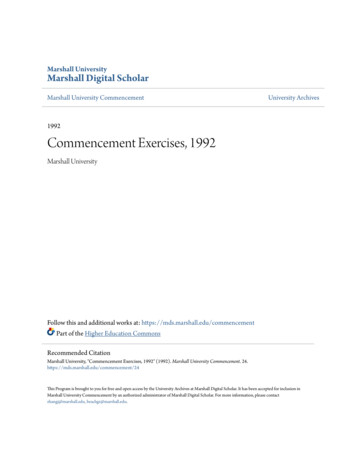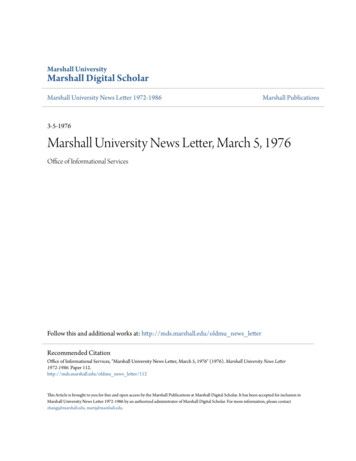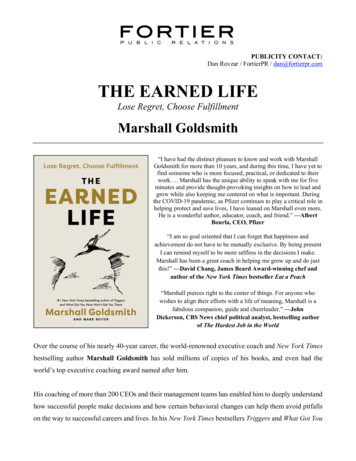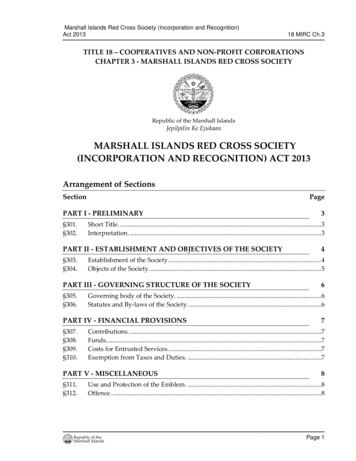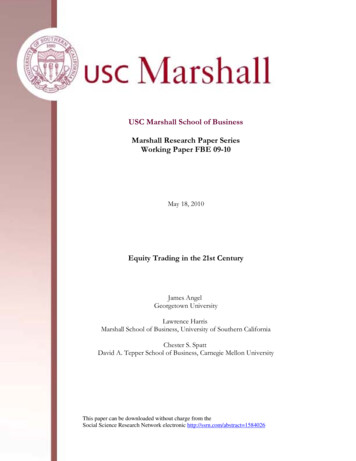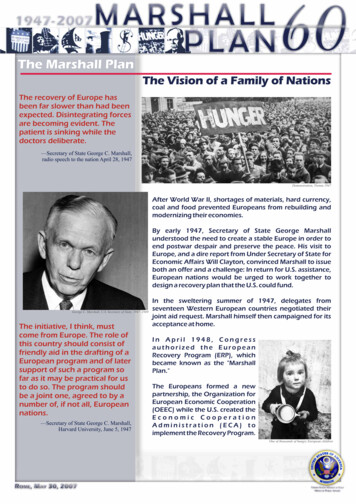
Transcription
The Marshall PlanThe Vision of a Family of NationsThe recovery of Europe hasbeen far slower than had beenexpected. Disintegrating forcesare becoming evident. Thepatient is sinking while thedoctors deliberate.—Secretary of State George C. Marshall,radio speech to the nation April 28, 1947Demonstration, Vienna 1947After World War II, shortages of materials, hard currency,coal and food prevented Europeans from rebuilding andmodernizing their economies.By early 1947, Secretary of State George Marshallunderstood the need to create a stable Europe in order toend postwar despair and preserve the peace. His visit toEurope, and a dire report from Under Secretary of State forEconomic Affairs Will Clayton, convinced Marshall to issueboth an offer and a challenge: In return for U.S. assistance,European nations would be urged to work together todesign a recovery plan that the U.S. could fund.George C. Marshall, U.S. Secretary of State, 1947–1949The initiative, I think, mustcome from Europe. The role ofthis country should consist offriendly aid in the drafting of aEuropean program and of latersupport of such a program sofar as it may be practical for usto do so. The program shouldbe a joint one, agreed to by anumber of, if not all, Europeannations.—Secretary of State George C. Marshall,Harvard University, June 5, 1947In the sweltering summer of 1947, delegates fromseventeen Western European countries negotiated theirjoint aid request. Marshall himself then campaigned for itsacceptance at home.In April 1948, Congressauthorized the EuropeanRecovery Program (ERP), whichbecame known as the "MarshallPlan."The Europeans formed a newpartnership, the Organization forEuropean Economic Cooperation(OEEC) while the U.S. created theEconomic CooperationAdministration (ECA) toimplement the Recovery Program.One of thousands of hungry European children
The Recovery Program at WorkGetting the Word OutThe historic Talleyrand buildingin Paris housed several MarshallPlan divisions: Trade andPayments, Finance, Food andAgriculture, Industry, and Labor.A crowded Italian piazza where Marshall Plan films were projected fromspecial busesThe Plan ". . . Createdinnumerable ties of a personalnature between a largenumber of individuals, officials,businessmen, scholars, andordinary citizens in many walksof life—ties which had notexisted before the war andwhich were of necessity notalways, or entirely, harmoniousduring the war.”Eric Roll, Lord Roll of IpsdenChairman of the OEEC Programs CommitteeItalian children reading about the Marshall PlanAll needed their messages to goout: increase production, reducetrade barriers, and modernizefarm and factory. This task fell tothe Information Division.Atruly revived and modernizedEurope could be won only onfactory floors, in neighborhoods,and in villages.Puppets enchanted audiences while campaigning againsttrade barriersThrough film, radio, exhibits, andprint, the Information Divisionpromoted the program's goalsand countered Communistinfluence.One of the posters of the Marshall Plan in ItalyThe Marshall Plan and You, sent to every household in theNetherlands by the Dutch government, was typical ofbooklets distributed all over Western Europe to explain thePlan's projects and benefitsPuppets enchanted audiences while campaigning against trade barriers
The Recovery Program at WorkModernizing IndustryThere are no blueprints toguarantee results. We areentirely surrounded bycalculated risks.I profoundly believe that thepending program is the best ofthese risks.—Arthur H. Vandenberg, Chairman, U.S. SenateForeign Relations Committee, seekingCongressional support of legislation for a recoveryprogram, March 1948Most OEEC countries had industries—from shipbuilding totextiles, glass making to fertilizer—needing support andrevitalization. TheMarshall Plan helped tocreatejobsandmodernize factories andEquipment.Increased bottle production, ItalyMore Western European products began toappear in American and Canadian markets,including English china, Vespa scooters, Danishhams, French wines, Dutch cheeses, and sportyEuropean cars.Dollars earned through those exports helpedmodernize factories.And increasing numbers of tourists broughtdollars directly to the “Old World.”CRC102A - The First Computer in Italy, delivered at ‘Istituto di Elettronica Generale’,University of Milan, on October, 1954Italian Olivetti typewriters became a fixture in offices inWestern Europe and the United StatesSporty Italian transportation for a new generationA giant hydroelectric project in Portugal nearing completion
The Recovery Program at WorkConstruction and ReconstructionEuropeans began to rebuild after the war but the taskwas daunting. Rubble had to be cleared, equipmentwas scarce, and raw materials were in short supply.TheMarshall Plan supportedboth new constructionand reconstruction ofw a r - d a m a g e dbusinesses and houses,especially critical inregions where refugeeswere flooding in, hopingCoal for Denmarkfor better lives.Construction worker in Naples, ItalyMarshall Plan dollars wereThanks to the Marshall Plan,the economy of the democraticpart of Europe was saved. .The success was a strikingdemonstration of theadvantages of cooperationbetween the United States andEurope, as well as among thecountries of Europethemselves.usedtomodernizetransportation systems,helping spur intra-Europeantrade and economicBuilding a road in Palermo, Italy.integration.— paul-henri spaakprime minister, belgium, 1947-1949Road-building, railway and other infrastructureprojects were essential to the success of the MarshallPlan.Part of a crate used to ship a Marshall aid commodity to France.Austria’s Kaprun Dam: hydroelectric power for homes, industries, ski lifts, and export
The Recovery Program at WorkAverting a Deepening CrisisIt is logical that the UnitedStates should do whatever it isable to do to assist in thereturn of normal economichealth in the world, withoutwhich there can be no politicalstability and no assured peace.Our policy is directed notagainst any country ordoctrine but against hunger,poverty, desperation andchaos.Marshall Plan aid supportedpublic health services andnutritionprogramsthroughout Western Europe,especially for children.A mine worker in postwar Sicily, where Marshall Plan fundswere committed to reconstruction and economic development.George C. Marshall, June 5, 1947An American tractor for a French farm familyThe drought of 1947 and the harsh winter that followedput many European lives in peril. Emergency shipmentsof food, fuel, and fertilizer were essential in the earlymonths of the Marshall Plan.Fishing in Denmark with nets made in Italy from cotton produced in the United States.Everything we did was tostrengthen European unity.—W. Averell HarrimanA young Dutchman learning to operate a self-propelled combine in Pennsylvania
The Marshall PlanChallenge and ResponseMarshall Plan funding went beyond healing theeconomy. It infused Western Europeans withhope and a renewed sense of strength. AsMarshall Plan projects rebuilt communities,Europeans replaced "old world" technologieswith "new world" vision. Leader workedalongside leader and laborer alongside laboreras Marshall's diplomatic foresight stimulatedfriendships and good will.European countries that were part of the Marshall PlanPeace and freedom are noteasily achieved. They cannotbe attained by force. Theycome from mutualunderstanding andcooperation, from awillingness to deal fairly withevery friendly nation in allmatters political and economic.—President Harry S. Truman, March 1947After decades of war theMarshall Plan set the stage forrecovery in Europe. Still, bitterrivalries would need to beovercomeandsomesovereignty surrendered inECA Administrator Paul Hoffman meets with ItalianPrime Minister Alcide de Gasperi, October 1950.order to end further cycles of violence.In 1951, with the U.S. Urging cooperation, six WesternEuropean nations—France, Germany, Italy Belgium,Luxembourg and The Netherlands—broke with the past tocreate a plan that would use their industries and vitalresources for peaceful production rather than forinstruments of war.U.S. President Harry S Truman with George C. Marshall, Paul G. Hoffman,and Averell Harriman, 1948
In 1950, artists from 13 Marshall Plan countries took part in acompetition to create posters capturing the goals and spirit ofthe Marshall Plan. From some 10,000 designs submitted, anintra-European jury in Paris made up of museum curators, arteducators, and others chose 25 of the posters for productionand distribution throughout Western Europe.Twelve of the winning posters are shown here.
Il Piano MarshallGli aiuti all’ItaliaGLI AIUTI IN EUROPAIn Milioni di Regno UnitoFranciaItaliaNoi vi chiediamo di assisterci.Noi siamo una Nazione chelavora duro e che hasoprattutto necessità di lavoro.Lavoro in patria medianteordinazioni per rifornimenticivili e militari, lavoro all’esteroattraverso l’ impegnotemporaneo o permanentedella mano d’opera eccedente.I nostri amici americani sonotestimoni dell’ industriosità delnostro popolo.—Alcide De Gasperi, Washington,25 settembre, 19511510GermaniaOlandaGreciaAustriaBelgio & Nel 1950, il valore di 1 dollaro siaggirava intorno alle 650 lire. 1 650 lire1 lira del 1950 equivale a circa2Gli aiuti alle Industrie in Italia32002700Gli aiuti alla popolazione del Lazio1.210.610 QUINTALI DI GRANO464.443 QUINTALI DI FARINA253.437.000 dosi di PENICILLINA799.438 gr. DI STREPTOMICINAcentesimi di Euro: 30 volte ilvalore attuale della liraIn AlimentariCellulosa e CartaCementoCeramica e VetroEditoriale e StampaFerro e AcciaioGommaIndustria aeronauticaIndustria agricolaIndrustria chimicaIndustria cinematograficaIndustria elettricaIndustrie elettromeccanicheIndustria meccanicaIndustria metallurgicaIndustria minerariaMaterie PlastichePetrolioTelecomunicazioniTessiliIndustrie minori e 90,598Gli aiuti gestiti dalle IstituzioniIn 1lira(1950) 0,02 EuroIl valore attuale degli aiuti giuntiall’Italia tramite il Piano Marshallpuo’ essere stimato in circa15 MILIARDI DI EURO1,436,878,20Ministero del Tesoro567,429,00Ministero delle Finanze4,882,117,29Ministero Pubblica Istruzione450,447,29Ministero Industria e Commercio648,764,50Ministero Poste e Telecomunicazioni425,407,35Ministero dei TrasportiMinistero Agricoltura e Foreste520,704,8418,540,50Ministero Grazia e Giustizia138,793,60Ministero Marina Mercantile338,426,00Istituto Centrale di Statistica663,815,48Direzione Generale Aviazione Civile127,927,70Istituto Superiore di SanitàAlto Commiss. Igiene e Sanita' Pubblica 962,108,26Totale11,181,360,28
Il Piano MarshallI Documenti Originali5 giugno 19473 aprile 1948Il discorso diGeorge C. MarshallIl Presidente Trumanfirma il “ForeignAssistance Act”Il 5 giugno 1947, duranteun discorso tenutoall'Università di Harvard,il Segretario di StatoGeorge C. Marshallpropose un piano chep r e v e d e v a l ostanziamento di aiutifinanziari americani perla ricostruzionedell'Europa, devastatadal secondo conflittomondiale. Nel discorso,Marshall sottolineò lanecessità da parte dellenazioni Europee di determinare leproprie necessità economiche e dichiaròche gli aiuti provenienti dagli Stati Uniti sarebbero dovuti essereresi disponibili a tutti i Paesi Europei, compresi quelli del bloccosovietico.12 marzo 1947Il Presidente U.S.A.illustra la“Dottrina Truman”Il 12 marzo 1947,poche settimaneprima del discorso diMarshall ad Harvard,il presidente Trumanpronunciò dinanzi alCongresso undiscorso divenuto poicelebre come “LaDottrina Truman”.Secondo il Presidenteamericano, dovevaessere “ferma politicadegli Stati Unitiaiutare i popoli liberinel resistere ait e n t a t i v i d iassoggettamento daparte di minoranzaarmate o da pressioniesterni”.Con questo atto, in cui si riconoscevano i primi 400 milioni di dollariin aiuti militari ed economici alla Grecia ed alla Turchia, aveva inizioquella che per i successivi 40 anni sarebbe stata la Guerra Fredda trail blocco occidentale e l’area di influenza sovietica.Dopo il discorso diGeorge Marshallall’Università diHarvard,il19dicembre 1947 ilPresidente Trumaninviò al Congresso laproposta di legge diattuazione del pianod ia i u t ia l l aricostruzioneeuropea.Il 3 aprile 1948 Truman firmò la legge istitutiva dell’Economic Recovery Act, divenuto poi noto con il nome di “MarshallPlan”, dal nome del suo ideatore.25 settembre 1951Alcide De Gasperiparla alCongresso U.S.A.Nel 1951 Alcide DeGasperi, capo delgoverno italiano, si recònuovamente aWashington, dove giànei primi mesi del 1947era andato a colloquiocon il PresidenteTruman per perorare lac a u s ad e l l aricostruzione. Il 25settembre del ‘51 fuinvitato a tenere undiscorso al Congresso, ilprimo per uno statistaitaliano, durante ilquale riaffermò lepolitiche filo-occidentali dell’Italia, e ribadìl’importanza che gli aiuti americani ebbero econtinuavano ad avere per la fragile economiaitaliana.
The Marshall PlanLa guerra fredda dei fumettiUn fumetto a commento del Marshall Plan,pubblicato sul New York Times il 24 aprile1949.Illustrazione di Edwin Marcus, apparsa sul NewYork Times il 14 marzo del 1948,sullecontroversie che accompagnarono l’attuazionedel Piano Marshall.Nel 1949, il governo olandese pubblica un libretto a fumetti nel qualel’illustratore Jo Spier illustra i benefici apportati dal Piano Marshall perl’economia e la ricostruzione finanziaria, concesso dagli Stati Uniti aipaesi Europei devastati dalla guerra.“CAN HE BLOCK IT?”Questo disegno del 1947 ironizza sull’opposizione al PianoMarshall del leader sovietico Joseph Stalin, qui dipinto come ungiocatore di basket che tenta di bloccare gli aiuti statunitensi.‘La Pace è esclusa dal paradiso.' Il 20 luglio 1950, il periodico satiricoSovietico Krokodil denunciava il Piano Marshall, dipingendolo come unpericoloso rifugio al servizio degli interessi economici, militari e religiosidell’Occidente.Il periodico sovietico Izvestiya denunciava il 3novembre 1949 quella che considerava lapolitica imperialista della EconomicCooperation Administration (ECA).Nel dicembre 1947, il fumettista tedesco ErnstMaria Lang commentava le paure dell’Europanei riguardi del conflitto tra gli alleatioccidentali e l’Unione Sovietica.
U.S. Foreign Aid in 2007As a keystone of U.S.foreign policy, theMarshall Plan set aprecedent for helpingcountries combatpoverty, disease andmalnutrition.When the Marshall Planended on June 30, 1951,Congress, in the processof piecing together a newforeign aid proposaldesigned to unite militaryand economic programswith technical assistance,created the MutualSecurity Agency.After 1960, the newKennedy Administrationmade reorganization of,and recommitment to,foreign assistance a toppriority.þ More than 3 million lives are saved every year through USAID immunizationprograms.þ Life expectancy in the developing world has increased by about 33 percent,smallpox has been eradicated worldwide, and in the past 20 years, the numberof the world's chronically undernourished has been reduced by 50 percent.þ The United Nations Drinking Water Supply and Sanitation Decade, in whichUSAID played a major role, resulted in 1.3 billion people receiving safe drinkingwater sources, and 750 million people receiving sanitation for the first time.On November 3, 1961, PresidentJohn F. Kennedy established theU.S. Agency for InternationalDevelopment (USAID).Every day, all over the world, USAIDbrings hope to those who sufferfrom violence, health to those whostruggle with sickness, and supportto those who live in poverty. It isthese individuals—these uncountedmillions of lives—that are the truemeasure of USAID’s success and thetrue face of America’s foreignassistance programs.þ Literacy rates are up 33 percent worldwide in the last 25 years, and primaryschool enrollment has tripled in that period.þ USAID child survival programs have made a major contribution to a 10 percentreduction in infant mortality rates worldwide in just the past eight years.þ Millions of entrepreneurs around the world (many of them women) havestarted or improved small businesses through USAID assistance.
Marshall Plan supported both new construction and reconstruction of war-damaged businesses and houses, especially critical in regions where refugees were flooding in, hoping for better lives. Marshall Plan dollars were used to modernize transportation systems, helping spur intra-European trade and economic integration. Thanks to the Marshall Plan,


